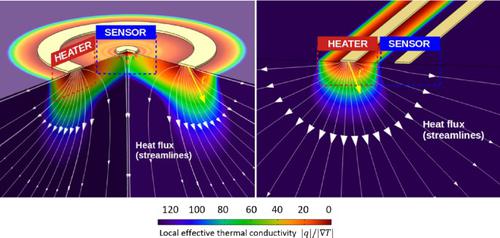Nano Research ( IF 9.9 ) Pub Date : 2020-11-27 , DOI: 10.1007/s12274-020-3129-6 Sami Alajlouni , Albert Beardo , Lluc Sendra , Amirkoushyar Ziabari , Javier Bafaluy , Juan Camacho , Yi Xuan , F. Xavier Alvarez , Ali Shakouri

|
We employ thermoreflectance thermal imaging to directly measure the steady-state two-dimensional (2D) temperature field generated by nanostructured heat sources deposited on silicon substrate with different geometrical configurations and characteristic sizes down to 400nm. The analysis of the results using Fourier’s law not only breaks down as size scales down, but it also fails to capture the impact of the geometry of the heat source. The substrate effective Fourier thermal conductivities fitted to wire-shaped and circular-shaped structures with identical characteristic lengths are found to display up to 40% mismatch. Remarkably, a hydrodynamic heat transport model reproduces the observed temperature fields for all device sizes and shapes using just intrinsic Si parameters, i.e., a geometry and size-independent thermal conductivity and nonlocal length scale. The hydrodynamic model provides insight into the observed thermal response and of the contradictory Fourier predictions. We discuss the substantial Silicon hydrodynamic behavior at room temperature and contrast it to InGaAs, which shows less hydrodynamic effects due to dominant phonon-impurity scattering.
中文翻译:

几何准弹道效应对纳米结构器件中热传递的影响
我们采用热反射热成像技术直接测量由沉积在硅基板上的纳米结构热源产生的稳态二维(2D)温度场,该纳米结构热源具有不同的几何构型和低至400nm的特征尺寸。使用傅立叶定律对结果进行的分析不仅会随着尺寸的缩小而破裂,而且无法捕获热源几何形状的影响。发现装配到具有相同特征长度的线形和圆形结构的基板有效傅里叶热导率显示出高达40%的失配。值得注意的是,流体动力传热模型仅使用固有的Si参数即可再现所有器件尺寸和形状的观察到的温度场。几何形状和尺寸无关的热导率和非局部长度尺度。流体动力学模型提供了对观察到的热响应以及相互矛盾的傅立叶预测的见解。我们讨论了室温下硅的基本流体动力学行为,并将其与InGaAs进行了对比,InGaAs由于占主导地位的声子-杂质扩散而显示出较小的流体动力学效应。


























 京公网安备 11010802027423号
京公网安备 11010802027423号